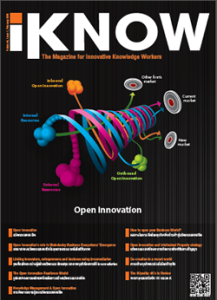iKNOW Volume 6 Issue 1 – Open Innovation
Combine endogenous and exogenous ideas through internal or external paths to market to develop advances in services, products or processes are the main objectives of organizations when they implement an open innovation (OI) strategy. Since Chesbrough’s fi rst description, the number of companies who have adopted OI has experienced a tremendous growth. Although the OI notion has emerged from the analysis of Open Source software development, nowadays, its logics encompass a large diversity of practices regarding the scope of openness applied in the innovation management. OI has become a specific movement with its own think tanks and lobbies and Open Data, Open Source, Open Standards and Maker movements (Hacklabs, Hackerspaces…) constitute extreme forms in the OI view. To support policies for OI at the European Commission, private firms, concerned citizens, scholars and even governments have created the European’s Open Innovation Strategy and Policy Group (OISPG). OI practices finally attracted the attention of European institutions that create their own economic development program: the European Collaborative and Regional Innovation Strategy (EURIS). Goals of this European Union commitment are to foster the creation of regional innovation ecosystems, to accelerate knowledge and technology exchanges, to generate new business opportunities, to promote entrepreneurship, and ultimately to improve quality of life, employment rates and living conditions. This European strategy is only an example of OI institutionalization. In Thailand, the government largely supports open innovation logics development in the Telecom industry, and even participates in their implementation in Agribusiness. More globally, OI logics are also applied to structure collaborations between developed and developing countries, entities and people. Such collaborations help to enhance true co-creation among partners in rich and poor regions, break down hierarchies, catalyze greater impact and produce more value for the involved actors and customers. In this special issue of iKNOW, OI implementation challenges are discussed through different perspectives.
OI participation in business ecosystem (BE) emergence is considered in biotechnological industries. Regarding the growing importance of bio-industries involvement in solving the current global ecological, food and health issues, trigger and support their BE development has become a capital issue. OI logics are now recognized as BE key factors of success, but how do they intervene? In the first article, Dr. Xavier Parisot connects the major components required to answer this question. Platforms also play a crucial role in BE by enabling the coordination of its members and strengthening their relationships along its lifecycle. In the second article, Dr. Denis and Elena Lescop describe how OI enhance the binding and coordinator functions of platforms in BE. Intellectual property rights (IPR) management constitutes another issue raised by OI logics deployment. However, if OI and IP strategies may appear conflicting, Pr. Pascal Corbel demonstrates in the third article, that it is possible to align them turning the protective role of patents into a bargaining power. Further upstream of the OI phenomenon, the significant role of innovation intermediaries (innomediaries) in linking innovators with entrepreneurs is explored by Dr. Thierry Isckia in his article. To complete this presentation, a concrete example of connective tool applied by one French innomediary company: IdeXlab, is presented by its CEO: Dr. Jean-Louis Lievin. While open innovation implementation always comes with a risk, firms need to determine if their organizational structure, management style, ability to share knowledge, skills and / or intellectual property… are adapted or adjustable to OI logics. However, the number of parameters to check is important and the strength of their interdependence is fluctuant. The open innovation readiness model (OIRAM) presented by Dr. Naphunsakorn Waiyawuththanapoom in the next article seek to connect and assess these critical factors. The aim of this model is to provide an effi cient tool to help organizations to appraise their OI readiness and to increase corporate proclivity towards OI logics. To conclude this focus on OI, the last upstream subject explores co-creation. This process is of particular interest as it represents an important triggering factor for the emergence of OI logics. Vadim Shiryaev, (President of SOMAR – Business Development Organizations Union), presents his practitioner vision, the requirements, operationalization and usual challenges attached to the co-creation process. Regarding the importance of OI today, it would have been impossible to cover all the related topics in one issue. Nevertheless, I would like to thank our contributors to this issue of iKnow for taking the time to introduce you in a synthetic way to some of the dominant problematic on the subject. I hope you will enjoy reading this special issue and that you will find some useful answers to the development of your innovation strategy
We wish you an inspiring reading and hope you enjoy this year’s first issue of iKNOW.
Xavier Parisot (Guest editor) & Manasi Shukla (Associate editor)
Read and Download this issue of iKNOW

